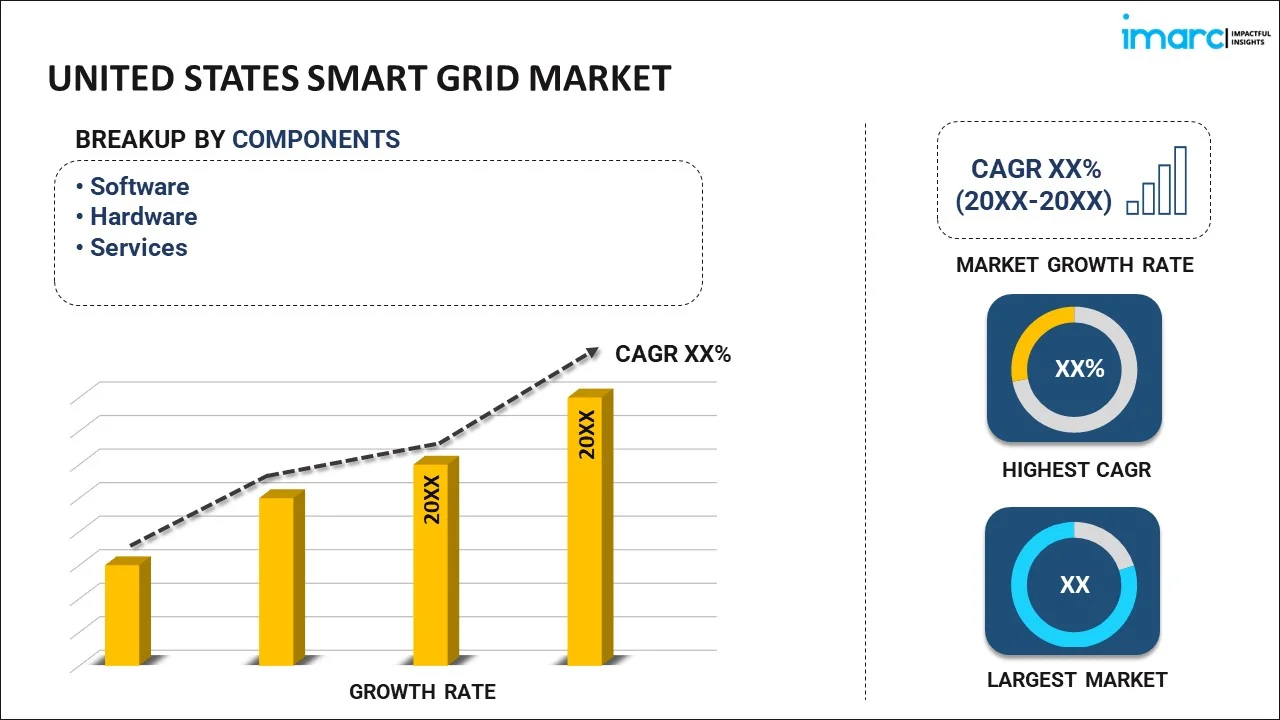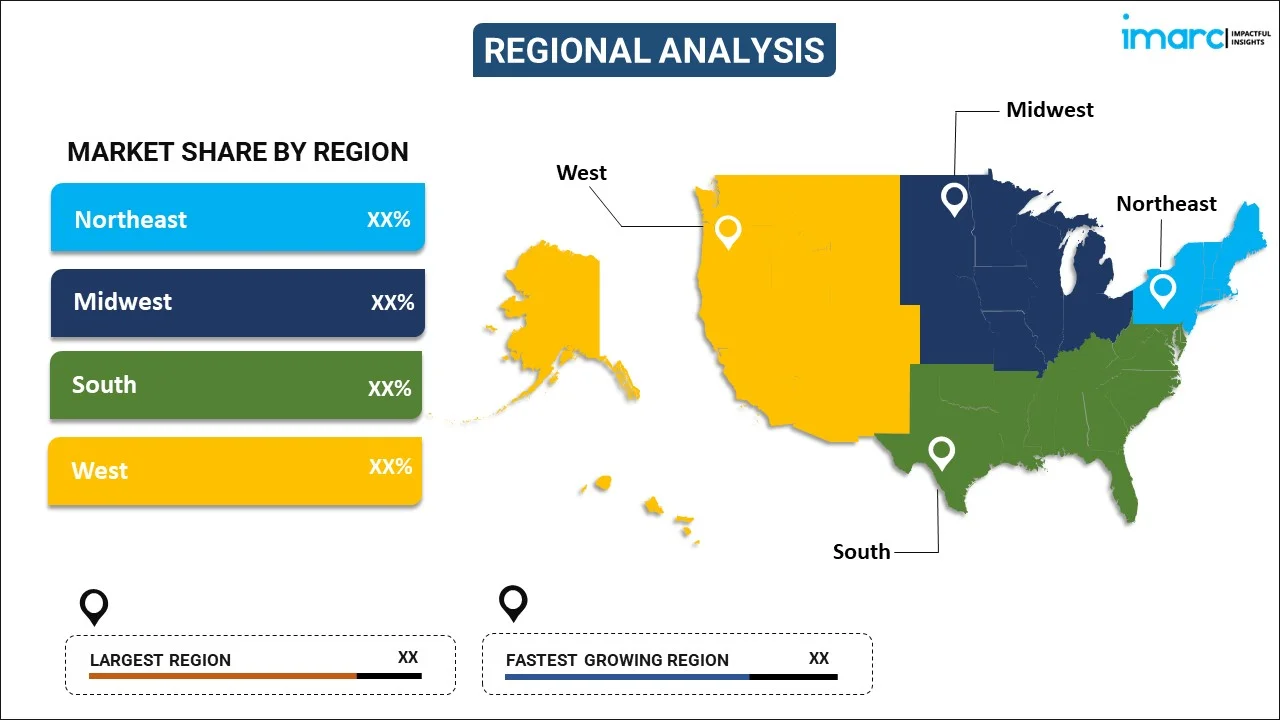
United States Smart Grid Market Report by Component (Software, Hardware, Services), End User (Residential, Commercial, Industrial), and Region 2025-2033
Market Overview:
United States smart grid market size is projected to exhibit a growth rate (CAGR) of 15.49% during 2025-2033. The rapid integration of renewable energy sources, the implementation of supportive regulations, continuous advancements in technology, increasing need to replace aging grid infrastructure, and the rising concern about cybersecurity represent some of the key factors driving the market.
|
Report Attribute
|
Key Statistics
|
|---|---|
|
Base Year
|
2024 |
|
Forecast Years
|
2025-2033
|
|
Historical Years
|
2019-2024
|
| Market Growth Rate (2025-2033) | 15.49% |
A smart grid refers to an advanced electrical grid infrastructure that fundamentally enhances the efficiency, reliability, and sustainability of electricity services. It integrates digital communication technology with the electricity network, enabling two-way communication between utilities and consumers. Smart grid includes various types, such as advanced metering infrastructure (AMI), distribution grid management, grid optimization, and renewable integration. It is comprised of several components, including smart meters, sensors, digital relays, and advanced analytics software. Smart grid possesses a range of features, such as real-time monitoring, demand response, grid automation, and self-healing capabilities. It is widely used for improving energy management, integrating renewable energy sources, charging electric vehicles (EVs), managing outages, balancing load, tracking consumer energy usage, enhancing grid security, and controlling voltage. The smart grid offers several benefits, such as energy efficiency, reduced operational costs, improved grid reliability and resilience, optimized energy consumption, increased consumer engagement, reduced greenhouse gas emissions, and promotion of energy independence.
United States Smart Grid Market Trends:
The rapid integration of renewable energy sources like solar and wind into the energy infrastructure is facilitating the demand for smart grids to manage the variability and distributed nature of these resources. Additionally, the implementation of supportive regulations by the federal and state governments promoting energy efficiency and grid modernization is boosting the market growth. Besides this, continuous advancements in technology, such as the Internet of Things (IoT) and artificial intelligence (AI), contributing to the development of more efficient and intelligent grid systems, are catalyzing the market growth. Furthermore, the increasing need to replace aging electrical infrastructure with modern, efficient systems is contributing to the market growth. In addition, the rising consumer demand for reliable and uninterrupted power supply is bolstering the market growth. Apart from this, the rising concerns about cybersecurity in the energy sector, prompting the adoption of smart grids that offer enhanced security features, are fueling the market growth. Moreover, the growing adoption of EVs, which necessitates an advanced grid infrastructure for efficient charging and load management, is providing a considerable boost to the market growth. Along with this, the decreasing costs of smart grid technologies, including sensors and smart meters, making them more accessible, are driving the market growth. Additionally, the escalating need for improved grid resilience and reliability in the face of natural disasters and extreme weather events is favoring the market growth. Furthermore, the ongoing shift towards decentralized power generation, including microgrids, is acting as another growth-inducing factor. Besides this, the implementation of stringent environmental regulations, necessitating the adoption of smart grids to achieve cleaner energy production and usage, is driving the market growth.
United States Smart Grid Market Segmentation:
IMARC Group provides an analysis of the key trends in each segment of the market, along with forecasts at the country level for 2025-2033. Our report has categorized the market based on component and end user.
Component Insights:

- Software
- Advanced Metering Infrastructure
- Smart Grid Distribution Management
- Smart Grid Network Management
- Substation Automation
- Others
- Hardware
- Sensor
- Programmable Logic Controller
- AMI Meter
- Networking Hardware
- Others
- Services
- Consulting
- Support and Maintenance
- Deployment and Integration
The report has provided a detailed breakup and analysis of the market based on the component. This includes software (advanced metering infrastructure, smart grid distribution management, smart grid network management, substation automation, and others), hardware (sensor, programmable logic controller, AMI meter, networking hardware, and others), and services (consulting, support and maintenance, and deployment and integration).
End User Insights:
- Residential
- Commercial
- Industrial
A detailed breakup and analysis of the market based on the end user have also been provided in the report. This includes residential, commercial, and industrial.
Regional Insights:

- Northeast
- Midwest
- South
- West
The report has also provided a comprehensive analysis of all the major regional markets, which include the Northeast, Midwest, South, and West.
Competitive Landscape:
The market research report has also provided a comprehensive analysis of the competitive landscape in the market. Competitive analysis such as market structure, key player positioning, top winning strategies, competitive dashboard, and company evaluation quadrant has been covered in the report. Also, detailed profiles of all major companies have been provided.
United States Smart Grid Market Report Coverage:
| Report Features | Details |
|---|---|
| Base Year of the Analysis | 2024 |
| Historical Period | 2019-2024 |
| Forecast Period | 2025-2033 |
| Units | Billion USD |
| Scope of the Report | Exploration of Historical and Forecast Trends, Industry Catalysts and Challenges, Segment-Wise Historical and Predictive Market Assessment:
|
| Components Covered |
|
| End Users Covered | Residential, Commercial, Industrial |
| Regions Covered | Northeast, Midwest, South, West |
| Customization Scope | 10% Free Customization |
| Post-Sale Analyst Support | 10-12 Weeks |
| Delivery Format | PDF and Excel through Email (We can also provide the editable version of the report in PPT/Word format on special request) |
Key Questions Answered in This Report:
- How has the United States smart grid market performed so far and how will it perform in the coming years?
- What has been the impact of COVID-19 on the United States smart grid market?
- What is the breakup of the United States smart grid market on the basis of component?
- What is the breakup of the United States smart grid market on the basis of end user?
- What are the various stages in the value chain of the United States smart grid market?
- What are the key driving factors and challenges in the United States smart grid?
- What is the structure of the United States smart grid market and who are the key players?
- What is the degree of competition in the United States smart grid market?
Key Benefits for Stakeholders:
- IMARC’s industry report offers a comprehensive quantitative analysis of various market segments, historical and current market trends, market forecasts, and dynamics of the United States smart grid market from 2019-2033.
- The research report provides the latest information on the market drivers, challenges, and opportunities in the United States smart grid market.
- Porter's five forces analysis assist stakeholders in assessing the impact of new entrants, competitive rivalry, supplier power, buyer power, and the threat of substitution. It helps stakeholders to analyze the level of competition within the United States smart grid industry and its attractiveness.
- Competitive landscape allows stakeholders to understand their competitive environment and provides an insight into the current positions of key players in the market.
Need more help?
- Speak to our experienced analysts for insights on the current market scenarios.
- Include additional segments and countries to customize the report as per your requirement.
- Gain an unparalleled competitive advantage in your domain by understanding how to utilize the report and positively impacting your operations and revenue.
- For further assistance, please connect with our analysts.
 Inquire Before Buying
Inquire Before Buying
 Speak to an Analyst
Speak to an Analyst
 Request Brochure
Request Brochure
 Request Customization
Request Customization




.webp)




.webp)












